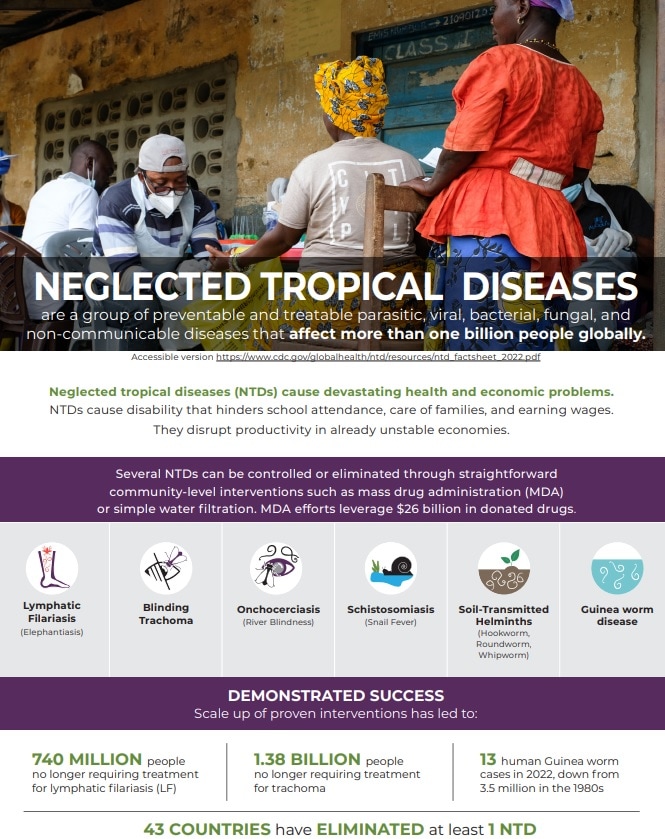Neglected Tropical Diseases Factsheet
NEGLECTED TROPICAL DISEASES are a group of preventable and treatable parasitic, viral, bacterial, fungal, and non-communicable diseases that affect more than one billion people globally.
Neglected tropical diseases (NTDs) cause devastating health and economic problems. NTDs cause disability that hinders school attendance, care of families, and earning wages. They disrupt productivity in already unstable economies.
Several NTDs can be controlled or eliminated through straightforward community-level interventions such as mass drug administration (MDA) or simple water filtration. MDA efforts leverage $26 billion in donated drugs.
- Lymphatic Filariasis (Elephantiasis)
- Blinding Trachoma
- Onchocerciasis (River Blindness)
- Schistosomiasis (Snail Fever)
- Soil-Transmitted Helminths (Hookworm, Roundworm, Whipworm)
- Guinea worm disease
DEMONSTRATED SUCCESS
- 740 MILLION people no longer requiring treatment for lymphatic filariasis (LF)
- 1.38 BILLION people no longer requiring treatment for trachoma
- 13 human Guinea worm cases in 2022, down from 3.5 million in the 1980s
43 COUNTRIES have ELIMINATED at least 1 NTD
CDC’s EFFORTS
CDC’s Division of Parasitic Diseases and Malaria translates science into action.
- Researching better laboratory surveillance tools and making them ready for use by country programs where these diseases are being eliminated
- Identifying approaches to improve coverage of MDA for NTDs, and improving morbidity management and disability prevention for individuals suffering with LF
- Developing approaches to improve surveillance and better measure NTD program impact
- Assisting countries with implementing their programs and using new tools
- Providing global scientific leadership on NTD elimination through collaborations with World Health Organization (WHO) and others
SPOTLIGHT ON KEY CDC ACCOMPLISHMENTS AND ACTIVITIES
- Developing a new blood test to more easily assess trachoma transmission in a community
- Strengthening capacity in labs in Africa
- Developing lab-based surveillance strategies, including leading efforts to implement integrated surveillance to detect more than 30 parasitic, viral, and bacterial diseases from a single, small blood sample
- Providing support in the Americas, including American Samoa (a U.S. territory), Haiti, and Guyana to eliminate LF
- Using data to strengthen disease elimination efforts for LF, river blindness, and schistosomiasis
- Serving as a WHO Collaborating Center for Guinea worm disease and blinding trachoma
WHAT’S NEEDED
- Continue scale up of proven interventions
- Expand and strengthen surveillance for datadriven decision making
- Develop and deploy new diagnostic tools, new interventions, and new surveillance approaches
- Assist countries that have not yet reached elimination to improve and maintain their technical capacity
FOR MORE INFORMATION
To learn more about CDC’s work to prevent, control, and eliminate parasitic diseases, visit https://www.cdc.gov/parasites/
